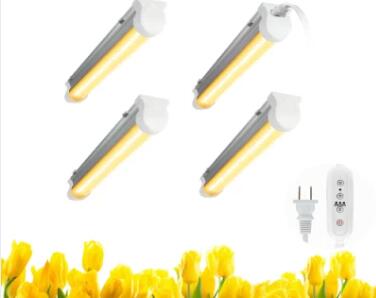Illuminating Growth: The Science Behind LED Grow Lights
2024-02-22
In recent years, LED (Light Emitting Diode) grow lights have gained popularity as an efficient and effective alternative to traditional lighting sources for indoor plant cultivation. With advancements in LED technology and a growing body of research, these lights have been shown to significantly enhance plant growth and productivity across various crops. In this blog post, we'll explore the scientific evidence supporting the use of LED grow lights for maximizing plant growth and productivity.
1. Optimized Light Spectrum:
One of the key advantages of LED grow lights is their ability to emit specific wavelengths of light tailored to plant growth requirements. Research has shown that plants utilize different wavelengths of light for various physiological processes, including photosynthesis, flowering, and fruiting. LED grow lights can be customized to provide optimal light spectra for different stages of plant growth, resulting in enhanced photosynthetic efficiency and overall productivity.
2. Energy Efficiency:
LED grow lights are renowned for their energy efficiency compared to traditional lighting sources such as fluorescent or high-pressure sodium (HPS) lights. Studies have demonstrated that LED grow lights convert a higher percentage of electrical energy into photosynthetically active radiation (PAR), the wavelengths of light utilized by plants for photosynthesis. This improved energy efficiency translates to reduced electricity costs and lower environmental impact, making LED grow lights a sustainable choice for indoor farming operations.
3. Control Over Light Intensity and Duration:
LED grow lights offer precise control over light intensity and duration, allowing growers to optimize lighting conditions for specific plant species or growth stages. Research has shown that manipulating light intensity and photoperiod (the duration of light exposure) can influence plant growth, development, and physiological responses such as flowering and fruiting. LED grow lights enable growers to customize lighting schedules to mimic natural daylight cycles or tailor light exposure to meet the needs of individual crops.
4. Minimized Heat Production:
Unlike traditional lighting sources, which emit a significant amount of heat, LED grow lights produce minimal heat output. This is advantageous for indoor farming environments where excessive heat can cause stress or damage to plants, especially during the summer months. Studies have demonstrated that maintaining optimal temperature conditions through the use of LED grow lights can promote healthy plant growth, minimize water loss through transpiration, and reduce the risk of heat-related stress disorders.
5. Increased Yield and Nutrient Density:
Numerous studies have reported significant increases in crop yield and nutrient density when using LED grow lights compared to conventional lighting systems. LED-induced improvements in photosynthetic efficiency, plant morphology, and physiological processes contribute to higher biomass accumulation, larger fruit sizes, and enhanced nutritional quality in harvested produce. Additionally, LED grow lights have been shown to promote secondary metabolite synthesis, leading to higher concentrations of beneficial compounds such as vitamins, antioxidants, and phytochemicals in plants.
Conclusion: Illuminating the Future of Indoor Farming
In conclusion, the scientific evidence overwhelmingly supports the use of LED grow lights for maximizing plant growth and productivity in indoor farming environments. From their customizable light spectra and energy efficiency to precise control over light intensity and duration, LED grow lights offer unparalleled advantages for optimizing growing conditions and achieving superior crop yields. As research continues to advance and technology evolves, LED grow lights are poised to play an increasingly integral role in revolutionizing indoor agriculture and meeting the growing demand for sustainable food production worldwide.



